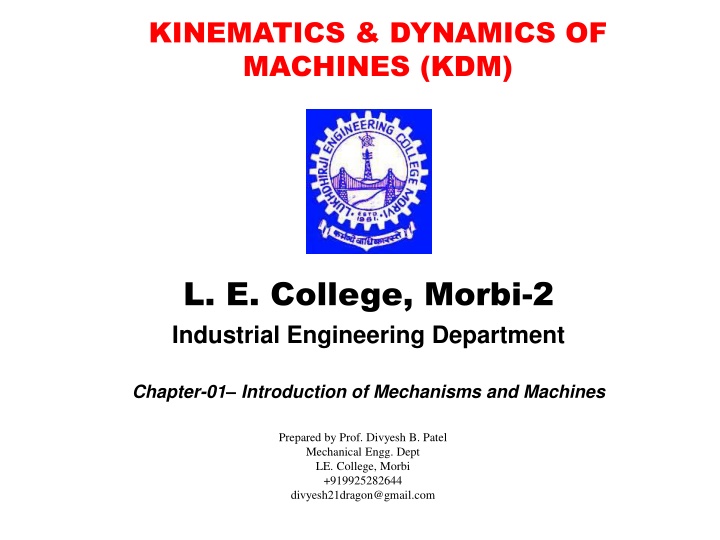
Introduction to Kinematics and Dynamics of Machines at L.E. College, Morbi-2
Dive into the world of Kinematics and Dynamics of Machines with an overview of mechanisms, kinematic chains, pairs, joints, and different cases to understand the concepts better. Explore the definitions, equations, and distinctions between locked, constrained, and unconstrained chains in this comprehensive guide by Professor Divyesh B. Patel from L.E. College, Morbi.
Download Presentation

Please find below an Image/Link to download the presentation.
The content on the website is provided AS IS for your information and personal use only. It may not be sold, licensed, or shared on other websites without obtaining consent from the author. If you encounter any issues during the download, it is possible that the publisher has removed the file from their server.
You are allowed to download the files provided on this website for personal or commercial use, subject to the condition that they are used lawfully. All files are the property of their respective owners.
The content on the website is provided AS IS for your information and personal use only. It may not be sold, licensed, or shared on other websites without obtaining consent from the author.
E N D
Presentation Transcript
KINEMATICS & DYNAMICS OF MACHINES (KDM) L. E. College, Morbi-2 Industrial Engineering Department Chapter-01 Introduction of Mechanisms and Machines Prepared by Prof. Divyesh B. Patel Mechanical Engg. Dept LE. College, Morbi +919925282644 divyesh21dragon@gmail.com
Kinematic Chain When the kinematic pairs are coupled in such a way that the last link is joined to the first link to transmit definite motion (i.e. completely or successfully constrained motion), it is called a kinematic chain. To determine the given assemblage for links from the kinematic chain or not: The two equations are l = 2p 4 (1) j = (3/2)*1 2 .(2) Where , l = number of links p = number of pairs j = number of joints
Pair v/s Joint Pair: it generally refers to the two machine members which are coupled, together based on their relative motion. the types are turning pair, sliding pair etc. example of turning pair is the piston and connecting rod. example of sliding pair is the piston and the internal surface of the cylinder walls. joint: it is the type of connection that exists between two machine members joined together, based on the relative motion existing between the members. example: the joint between piston and connecting rod is pin- joint.
Case No. -1 Case No. -2 Number of links, l = 3 Number of pairs, p = 3 Number of joints, j = 3 Number of links, l = 4 Number of pairs, p = 4 Number of joints, j = 4 l = 2p 4 3 = 2*3 4 = 2 l = 2p 4 4 = 2*3 4 = 4 L.H.S. > R.H.S. L.H.S. = R.H.S. j = (3/2)*1 2 3 = (3/2)*3 2 = 2.5 j = (3/2)*1 2 4 = (3/2)*4 2 = 4 L.H.S. > R.H.S. locked chain L.H.S. = R.H.S. constrained kinematic chain
Case No. -4 Case No. -3 Number of links, l = 5 Number of pairs, p = 5 Number of joints, j = 5 Number of links, l = 6 Number of pairs, p = 5 Number of joints, j = 7 l = 2p 4 5 = 2*5 4 = 6 l = 2p 4 6 = 2*5 4 = 6 L.H.S. < R.H.S. L.H.S. = R.H.S. j = (3/2)*1 2 5 = (3/2)*5 2 = 5.5 j = (3/2)*1 2 7 = (3/2)*6 2 = 7 L.H.S. < R.H.S. unconstrained chain L.H.S. = R.H.S. compound kinematic chain
Kinematic chain Kinematic chain is defined as the combination of kinematic pairs in which each links forms a part of two kinematic pairs and the relative motion between the links is either completely constrained or successfully constrained. Examples: slider-crank mechanism For a kinematic chain l = 2 p 4 = 2 (j + 2) / 3 Where l = no. of links, P = no. of Pairs and j = no. of joints When, LHS > RHS, then the chain is locked LHS = RHS, then the chain is constrained LHS < RHS, then the chain is unconstrained
Types of Joint: 1) Binary Joint: When two links are joined at the same connection, the joint is known as binary joint. 2) Ternary Joint: When three links are joined at the same connection, the joint is known as ternary joint. A ternary joint is equivalent to two binary joints
Types of Joint: 3) Quaternary Joint: When four links are joined at the same connection, the joint is called a quaternary joint. It is equivalent to three binary joints.
Mechanism When one of the links of a kinematic chain is fixed, the chain is known as mechanism. It may be used for transmitting or transforming motion e.g. engine indicators, typewriter etc. simple mechanism, compound mechanism
1) Kinematic pairs are those which have two elements that (a) have line contact (b) have surface contact (c) permit relative motion (d) are held together (e) have dynamic forces 2) Which of the following is a lower pair (a) ball and socket (b) piston and cylinder (c) cam and follower (d) (a) and (b) above (e) belt drive. 3) Pulley in a belt drive acts as (a) cylindrical pair (b) turning pair (c) rolling pair (d) sliding pair (e) surface pair.












